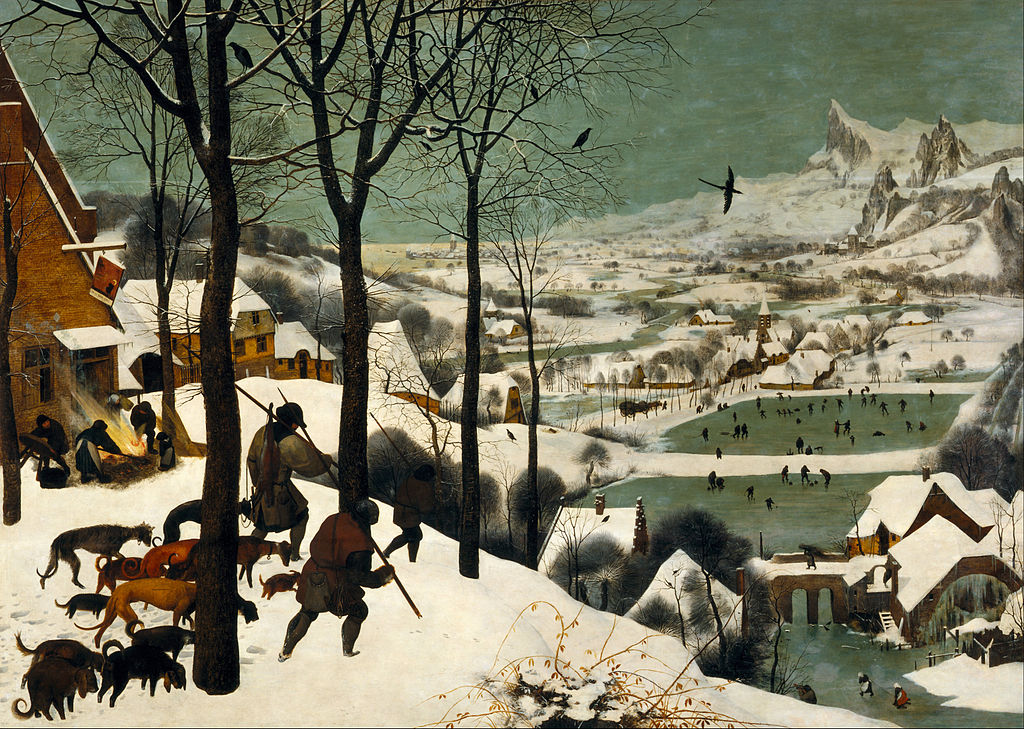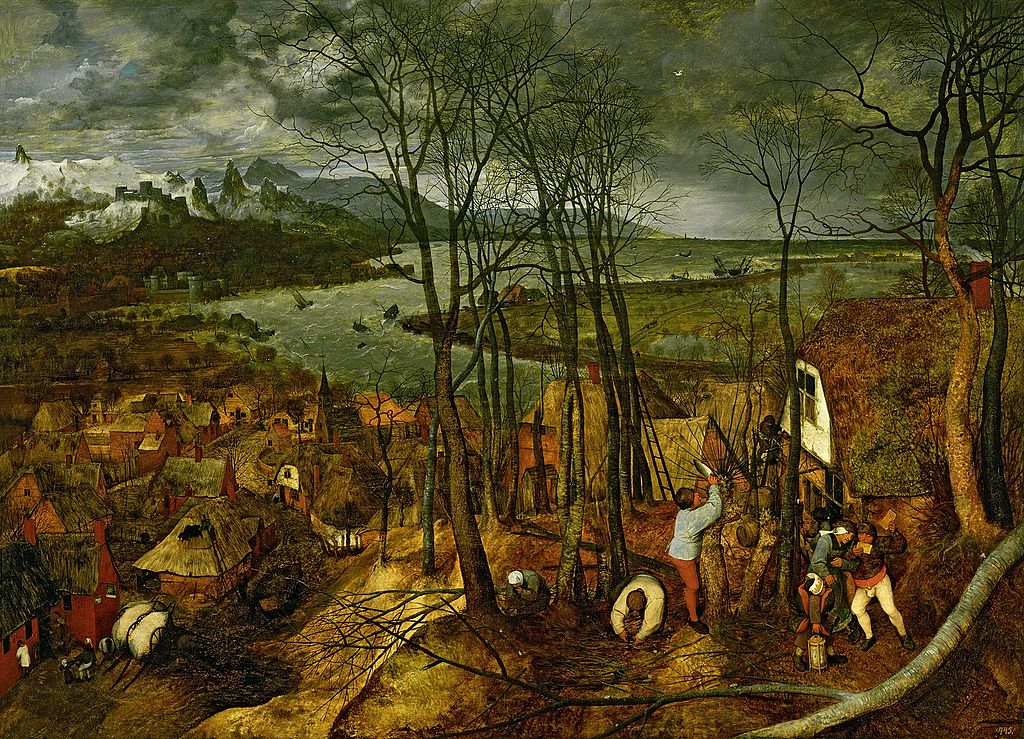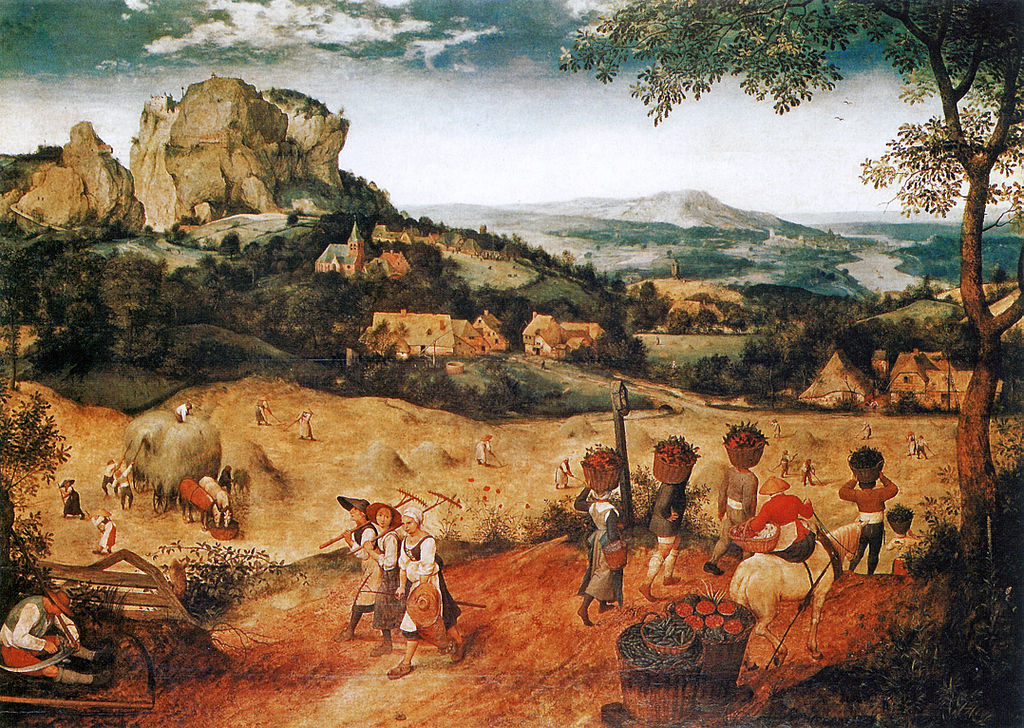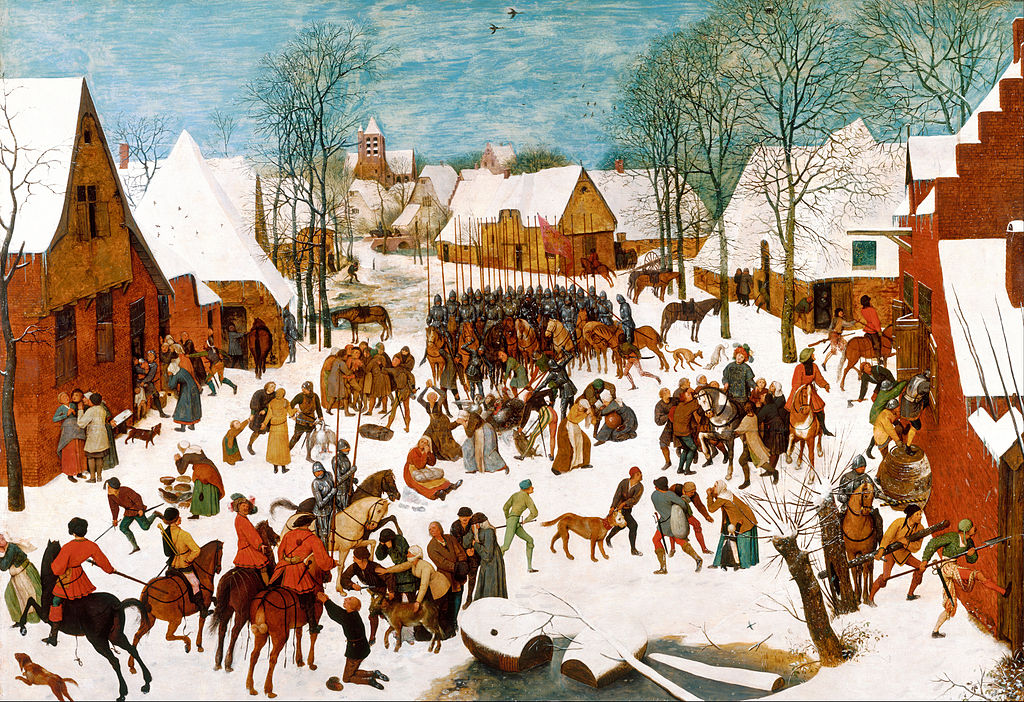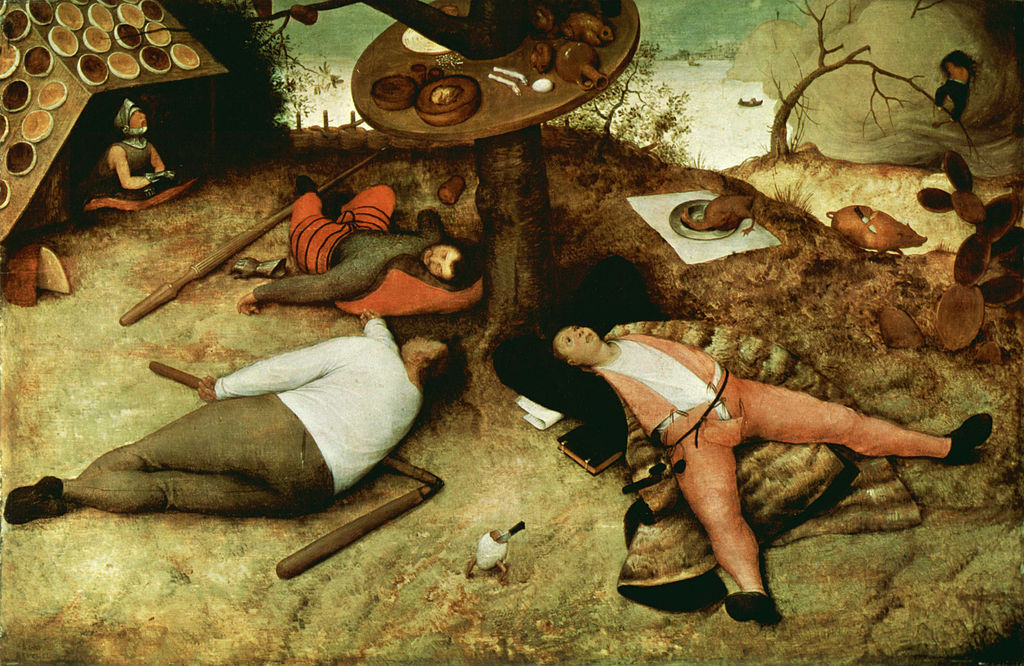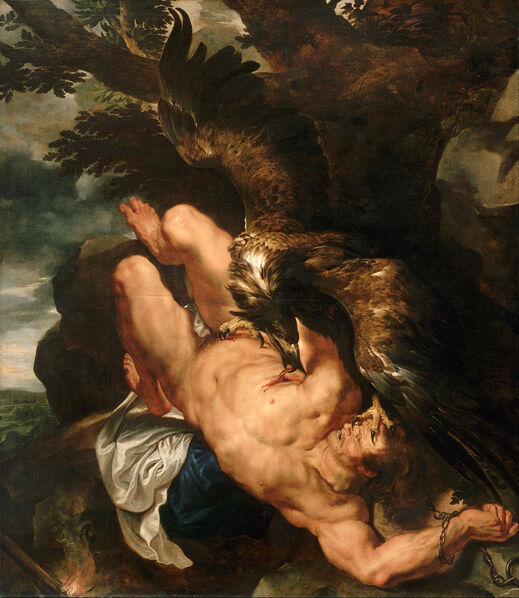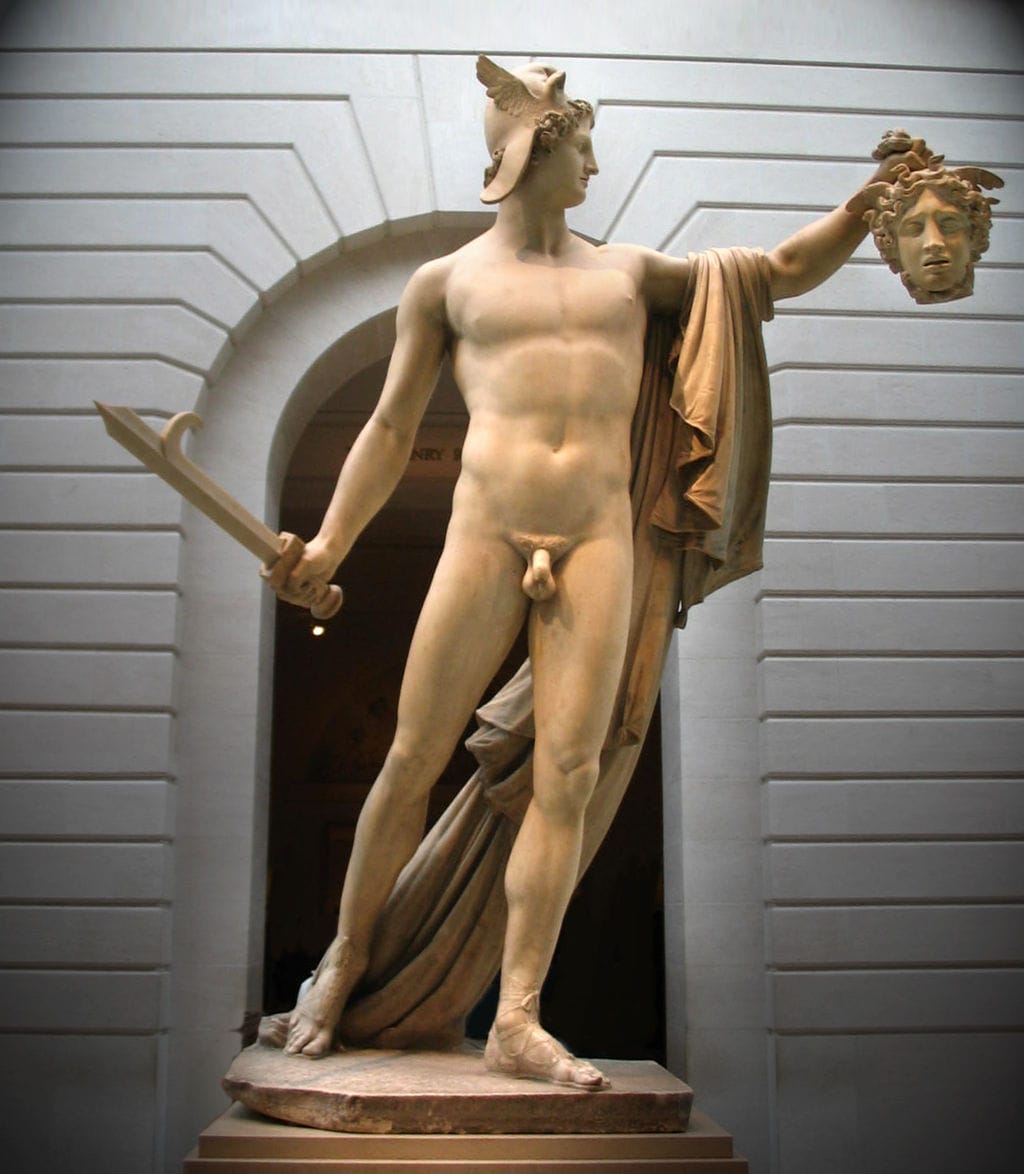|
Where? Room X on the First Floor of the Kunsthistorisches Museum
When? 1565 Commissioned by? Niclaes Jongelinck, a Belgian art collector and banker. What do you see? In the left foreground, a group of peasant hunters and their dogs trudge through heavy snow as they return home from a search for food. It looks like their day was largely unsuccessful as only one hunter carries the cadaver of a small fox, and the dogs look somewhat underfed. Slowly, they pass by a group of villagers roasting corn over a fire at the inn on the far left. The sign hanging above the inn falls lopsided, skewed, maybe by the wind. In front of the hunters are the footprints of a small animal, perhaps a rabbit that has escaped them. The dogs continue sniffing at the ground in the hopes of finding it. The hunters can already see their village. Tiny figures and silhouettes are scattered across the frozen waters as they play curling, hockey, and skate around in groups. Even further behind them are more white and brown houses surrounded by dead trees and black birds, bridges, and pointed towers all dwarfed by the massive snowy mountains that loom over the entire scene. Backstory: Pieter Bruegel the Elder created Hunters in the Snow as part of his series, the Seasons. Bruegel painted scenes of autumn, winter, early spring, early summer, and summer and a sixth painting of spring has not survived. The surviving pieces of this series include: The Gloomy Day, The Harvesters, The Return of the Herd, and The Hay Harvest. Two of these paintings are in the Kunsthistorisches Museum in Vienna, one is in Prague, and the last painting is in the Metropolitan Museum of Art. The six part series once included a painting of spring that was lost. The Seasons were commissioned for the dining room of Nicolaes Jonghelinck, a wealthy merchant and art collector from Antwerp. It’s likely that the paintings were spread out as a frieze on all four walls of the room, creating an immersive experience for the viewer. Hunters in the Snow is Bruegel’s depiction of winter. As with all his pieces, Bruegel packs each of his works with such great detail that many of the miniature scenes he creates are impossible to see with the naked eye. With these details, he crafts a realistic and immersive scene that draws viewers in and plants them into a familiar but fantastical world. Much of his work is concerned with the life of the peasant whom he respected. He gave viewers a look into the parts of their daily life.
Who is Bruegel the Elder? Pieter Bruegel the Elder was a Dutch painter who was born near Breda in 1525. Bruegel began his art career in 1555 at the Antwerp School of Art, where he created many engravings, mostly on the topic of sin, learning from the style of Hieronymous Bosch. In 1563, Bruegel left Antwerp and moved to Brussels where he would remain until his death. During this time, Bruegel began to paint more, creating his Seasons series as well as his Massacre of the Innocents in the Royal Collection in London. Much of his work was focused on day-to-day life and reality, standing in contrast to the Renaissance movement in Italy during this time.
Towards the end of his life, Bruegel painted in a “large-figure” style that sought to imitate the rhythm of dance. Works in this style include his The Blind Leading the Blind and The Land of Cockaigne. His attention to reality and detail made him one of the world’s first truly modern painters. Bruegel died in Brussels in 1569.  Detail of hunter shooting birds Detail of hunter shooting birds
Fun fact: Bruegel the Elder incorporated many details in his paintings, something that was characteristic of the Northern Renaissance style. A century before, Jan van Eyck had started this style. But Bruegel took this to another level. Some of these details can barely be seen with the naked eye. One of these includes a little hunter with a rifle shooting at some birds on the right side of the painting. With these minuscule details, Bruegel is able to create a world full of depth and truth.
0 Comments
Where? Room XIII on the First Floor of the Kunsthistorisches Museum
When? 1617-1618 What do you see? Perseus has just cut off the head of Medusa which is lying on top of a cliff. The edge of the cliff is on the right, and in the background is the rest of the mountain and some vegetation. The face of Medusa is very pale, her lips are black, and her pupils rolled down. A substantial amount of blood comes out of her neck. Before she died, the hair of Medusa consisted of snakes, and most of the snakes are still attached to her (if you look carefully you can see some snakes growing directly from her head). Some other snakes have detached and are trying to get away. There is a variety of snakes with different skins, shapes, and folds. On the top right, two snakes are biting each other, which may be part of a mating ritual. On the left, many snakes are wrestling with each other. From the blood that pours out of Medusa’s neck, small snakes are born. In the middle foreground, a small yellow snake has no tail but two heads instead. This snake represents the mythological amphisbaena, which is an ant-eating snake with two heads. The rolled-up snake to its left has the head of another animal. In the left foreground is also a beautiful fire salamander, to its right are two spiders, and further to the right a scorpion. Backstory: Frans Snyders, a specialist in painting animals, painted the snakes, other animals, and insects in this work. Snyders also assisted Rubens with several other paintings over a period of thirty years. For example, he painted the eagle in Rubens’ Prometheus Bound in the Philadelphia Museum of Art. According to the mythological story on Medusa, the snakes on her head are venomous. However, Snyders used the nonvenomous European grass snake as the model for the snakes in this painting. Some people, however, identify the two snakes on the right who are mating as vipers (and the viper is a venomous snake). A copy of this painting is in the Moravian Gallery in Brno, Czech Republic.
Who is Medusa? She was a Gorgon in Greek mythology. The term Gorgon is often used to refer to the three sisters, Stheno, Euryale, and Medusa, who looked like monsters and killed many people. Several sources describe them as the children of Phorcys and Ceto, though one source mentions that their father was called Gorgon. All three sisters had brass hands, sharp teeth, and their hair consisted of living venomous snakes. Whereas Stheno and Euryale where immortal, Medusa was not.
Medusa was killed by the Greek hero Perseus, who was sent by Polydectes, a king of a Greek island, who wanted to marry the mother of Perseus. Killing Medusa was not easy because everyone who would look at her would turn into stone. Perseus was able to kill Medusa by looking in a mirrored shield that he received from Athena. After he cut off Medusa’s head, the head could still be used to kill people who looked at it. Medusa in art? In 1596 and 1597, Caravaggio painted two versions of the head of Medusa on a shield. The first work is privately owned and the second Medusa is in the Uffizi Museum. Leonardo da Vinci also painted Medusa, as discussed in a book by Vasari, but this painting is lost now. Perseus and Medusa have also been the subject of some well-known sculptures of which the most famous example is probably Perseus with the Head of Medusa by Antonio Canova. The original version of this statue is in the Vatican Museums, and a copy is in the Metropolitan Museum of Art.
Who is Rubens? Peter Paul Rubens (1577-1640) was a Belgian painter during the Baroque period. Baroque painting differs from Renaissance painting by the increased use of color and emotions, and Rubens is one of the most important examples of that.
When Rubens was 23 years old, he moved to Italy where he spent the next eight years of his life. He traveled to places such as Florence, Rome, and Venice, and learned from the works of the great Renaissance artists. He returned to Belgium in 1608 where he set up his large studio. He had many students and often collaborated with other great artists such as Pieter Bruegel the Elder. Some other examples of the work of Rubens include Samson and Delilah in the National Gallery in London and Daniel in the Lions’ Den in the National Gallery of Art in Washington, DC.
Fun fact: After Perseus cut off the head of Medusa, the head was involved in a variety of events:
|
Categories
All
|
- Home
- Blog
-
Museums
- Alte Pinakothek
- Art Institute of Chicago
- Baltimore Museum of Art
- Barber Institute of Fine Arts
- Bargello
- Barnes Foundation
- British Museum
- Church of Sant’Anastasia
- Cleveland Museum of Art
- Courtauld Institute of Art
- Detroit Institute of Arts
- Frans Hals Museum
- Galleria Borghese
- Gallerie dell'Accademia
- Getty Museum
- Guggenheim
- Hermitage Museum
- Kunsthistorisches Museum
- Kunstmuseum Basel
- Legion of Honor Museum
- Louvre
- Mauritshuis
- Metropolitan Museum of Art
- Musee d’Orsay
- Museum of Fine Arts in Boston
- Museum of Modern Art
- National Gallery in London
- National Gallery of Art
- National Museum in Poznań
- Norton Simon Museum
- Ny Carlsberg Glyptotek
- Palace of Versailles
- Palazzo Pitti
- Palazzo Vecchio
- Petit Palais
- Philadelphia Museum of Art
- Prado
- Pushkin Museum
- Ravenna Art Museum
- Rijksmuseum
- San Diego Museum of Art
- Santa Maria delle Grazie
- St. Peter's Basilica
- Städel Museum
- Statens Museum for Kunst
- Tate Britain
- Tate Modern
- Timken Museum of Art
- Uffizi
- Vatican Museums
- Wallace Collection
-
Artists
- Altdorfer
- Anguissola
- Berlin Painter
- Bosch
- Botticelli
- Boucher
- Bronzino
- Bruegel the Elder
- Brunelleschi
- Cabanel
- Caillebotte
- Canova
- Caravaggio
- Carpeaux
- Cezanne
- Cimabue
- David
- Degas
- Delacroix
- De Maria
- Donatello
- El Greco
- Fontana
- Fra Angelico
- Fragonard
- Gauguin
- Gentileschi
- Gericault
- Gonzalez-Torres
- Goya
- Hals
- Hogarth
- Hokusai
- Ingres
- Leonardo da Vinci
- Lippi, Filippo
- Longhi, Barbara
- Lorrain
- Makovsky
- Manet
- Massys
- Matisse
- Merian
- Michelangelo
- Mochi
- Modigliani
- Monet
- Panini
- Parmigianino
- Perugino
- Picasso
- Pisanello
- Raphael
- Rembrandt
- Renoir
- Reynolds
- Rivera
- Rodin
- Rubens
- Scultori
- Seurat
- Steen
- Tintoretto
- Titian
- Toulouse-Lautrec
- Turner
- Uccello
- Van der Weyden
- Van Dyck
- Van Eyck
- Van Gogh
- Van Hemessen
- Vasari
- Velazquez
- Vermeer
- Veronese
- Vigée Le Brun
-
Locations
- Books
- About Us

